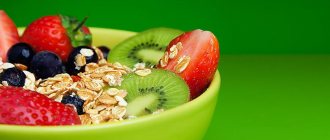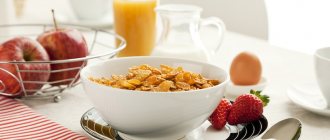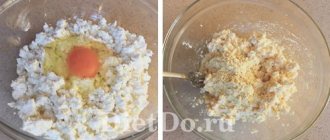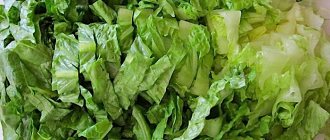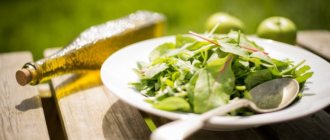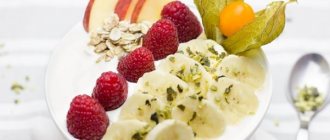“Space diet” by Sergei Sivokho: without denying himself anything, the comedian lost 42 kg in 3 months
Losing weight is promoted not only by sports, but also by proper nutrition. Healthy low-calorie food will not only saturate your body, but also fill it with useful substances.
A diet for weight loss should be varied and consist exclusively of healthy recipes and fresh foods. Convenience foods and other unhealthy foods will not only aggravate your health, but will also add stress to the body, in the form of a couple of extra pounds.
We’ll look at how to choose the right food for breakfast, what to avoid at lunch, and what an ideal dinner for weight loss should be like in the next article.
Why do you need to have breakfast?
Having slept all night, a person wakes up in the morning already hungry. Eating in the morning is especially useful because this meal charges you with energy for the whole day and starts the metabolic process in the body. The quality and quantity of food in the morning will determine whether your day will be productive or not.
Many people are accustomed to having a light breakfast. But nutritionists say that this habit needs to be changed. Those who neglect breakfast deprive their body of the substances and vitamins it needs.
You can often observe that a person is lethargic, drowsy, and has a feeling of fatigue. And then during lunch a person may already overeat, because the body wants what it lacks. Because of this, extra pounds and problems with the gastrointestinal tract. Therefore, food must be taken fully.
The importance of breakfast for the body
A hungry person does not think about work, but about what he wants to eat. Therefore, having had a good meal, your concentration will be better, and your memory will not deteriorate.
Doctors say that breakfast is important because it will help control your cholesterol and sugar levels in the body.
Eating a hearty meal in the morning is quite beneficial; it is the basis of a healthy diet, and not only that. If a person regularly skips his morning meal, then the feeling of hunger begins to torment him long before lunch. In such a state, it is difficult to control yourself and not throw everything “that is not nailed down” into yourself. It has long been a proven fact that a person who skips breakfast eats more during the day than those who do not.
The body has useful digestive enzymes that our body produces just in the morning. If a person does not eat in the morning, they disappear, and this can affect the functioning of the body.
Scientists have proven that people who eat breakfast have strong immunity and do not get sick as often.
Complementary feeding menu: what is best to give in the morning, lunch and evening
What foods to start complementary feeding with and how to diversify the diet of a child up to one year old? Polina Aleksandrovna Kizino, a pediatrician and leading expert of the online school for future and established parents “SMART Mama”, gives a useful menu for feeding a child during the day and recommendations on baby food.
— Polina Aleksandrovna, please tell us what complementary feeding is.
— Complementary feeding can be called a way of transition from milk feeding (breastfeeding, mixed or artificial feeding) to “adult” food, which the child will eat after some time from the common table.
— When to start complementary feeding, what recommendations do doctors give?
— There are several recommendations for introducing complementary foods:
- World Health Organization (WHO) - from about 6 months.
- Union of Pediatricians of Russia, more adapted to our environment - from 4-6 months.
Complementary feeding is introduced more often: from 5 months - when everything is fine with the child, from 4 months - in case of obvious deficiency conditions.
Important! “Hypoallergenic corridor” is a period from 4 to 7 months, during which you can introduce the maximum number of products with the lowest risk of allergies in the baby. View MAMAKO® baby food
— Polina Aleksandrovna, how can a mother competently create a child’s menu for the day?
— When a mother just begins to introduce her child to new foods, it is necessary to take into account that there is always the possibility of developing allergic reactions. Even if you give hypoallergenic foods, it is important to check how the child reacts to them. Therefore, it is advisable to introduce new foods in the first half of the day in order to have time to track the reaction that may occur in the child.
— What products can the morning feeding menu for babies consist of?
— If we talk about complete complementary feeding (the baby is already familiar with different types of food), then we will most likely give the child porridge in the morning complementary feeding. Porridge contains carbohydrates and other nutrients, gives the child a supply of energy and strength to start the morning actively, and maintain activity throughout the day, allowing him to play calmly without feeling hungry.
— What should you give your baby during the day for complementary feeding?
- If these are the first and second complementary foods, then most likely the child will receive only vegetables for lunch. Over time, the baby’s diet expands; he additionally receives dairy and meat products. For a daytime meal, you can consider cream soups from MAMAKO® with vegetables and goat milk, so that lunch is as complete as possible in its composition.
— What complementary foods are best to give to a baby for an afternoon snack and what to feed him in the evening?
- In the evening, you should try to give lighter foods so as not to overload the child - vegetables or fruit puree. You can supplement it with cottage cheese or other dairy product.
If a child cannot withstand breaks between night feedings well and often asks to eat at night, sometimes it is acceptable to give porridge at night (including milk porridge, if it is age appropriate).
— Why is it better to give your child different complementary foods?
— The child will at some point begin to consume adult food. And the sooner his mother begins to introduce him to different textures and products, different shapes and serving, the faster he will get used to it and the easier it will be to move to the “adult” table. If a child gets used to eating only purees and liquid foods, then it is already quite difficult to diversify his diet (the child will not be interested, he will continue to eat only purees - it’s easy and no effort is needed).
— At what age is it better to diversify a child’s complementary feeding?
— From the very beginning of introducing complementary foods, we try to diversify it. If vegetables are introduced as the first complementary food, the baby will try two or three vegetables. If porridge is introduced second, then first he will try one porridge, then the second, the third. It is quite difficult to say that diversity begins at a certain age; it begins from the first weeks of introducing complementary feeding to a small child.
Advice to mom: the older the child gets, the more varied and intense new foods should appear in his diet in order to reduce the risk of allergies to them in the future.
— Polina Aleksandrovna, tell us about MAMAKO® porridge with goat milk as a complete complementary food for a child.
— Two components are important here - a line of cereals for complementary feeding and their base - goat's milk.
- Assortment of cereals for complementary feeding MAMAKO®. A variety of cereals helps you choose a product that meets the child’s needs at the initial stages of introducing complementary foods and the stage of expanding nutrition. For example, for a younger child this is porridge with goat’s milk from one grain; to expand the diet - porridge from seven grains, porridge with the addition of fruits and berries.
- The benefits of goat's milk for first feeding.
Goat's milk, unlike cow's milk, has a lower potential risk of developing allergies. And if you choose between goat and cow milk, it is better to prefer porridge with goat milk in order to minimize the risk of allergies in your child.
When you are just introducing your child to new foods, try to introduce them into the child’s diet in the first half of the day.
to track the reaction. Once your child has become familiar with certain foods, you can distribute them throughout the day. This is done so that during the day the child has enough energy to play and develop, to be in a good mood, and in the evening not to overload the gastrointestinal tract. Then your baby will feel comfortable falling asleep and sleeping throughout the night.
Pediatrician Polina Aleksandrovna Kizino
*The ideal food for an infant is mother's milk. WHO recommends exclusive breastfeeding for the first 6 months. MAMAKO® supports this recommendation. Before introducing new foods into your baby’s diet, consult a specialist.
What is advisable to eat in the morning?
The ideal breakfast is porridge. It cleanses the intestines and energizes. Cereals contain a lot of vitamins and minerals that are beneficial for all organs of the human body.
The most commonly consumed is oatmeal. However, it is not suitable for everyone. If you belong to the category of people for whom oatmeal causes far from pleasant consequences, do not despair. There are many other cereals, and besides them there are many options for a proper breakfast.
An excellent option for breakfast is yogurt or muesli with fruit (with a small caveat - the right muesli!). You can also make an omelet with cheese, boil eggs, or just eat a light salad with fresh vegetables. Cottage cheese, turkey fillet or chicken breasts will be an excellent source of protein.
But it’s better to completely avoid coffee and various sausages. Such food simply clogs the stomach, and the body does not receive any benefit from it at all. If you really can’t live without coffee, then it’s better to drink it after a meal, and with the addition of milk.
What foods should be in the diet?
When deciding how to create proper nutrition for yourself and feed your family, it is worth understanding the main nuance - which foods are considered healthy? This point was partially discussed above, but let’s look at it in more detail. So, the diet should include:
- Protein foods of animal origin - meat, poultry, fish, eggs. For meat, give preference to turkey or chicken (lean pork and veal are allowed). Most of the fish should be sea fish.
- Greens and vegetables.
- Fats - olive and flaxseed oil, nuts.
- Fruit (but not too much).
- Plant proteins are primarily legumes.
- Dairy products - milk, cottage cheese, kefir. Preference should be given to products with low fat content.
- For sweets - dried fruits, marshmallows, marmalade.
- Yeast-free or whole grain bread .
Sample breakfast menu for the week
In the morning I don’t want to think about what to cook. Therefore, it will be much more convenient to create a sample menu for the whole week. This will make it easier to eat right, and you will have much more free time.
Nutrition, of course, must be correct, but strong restrictions lead to breakdowns. If you can’t imagine your life without sweets, morning is the ideal time for a “little crime.” Your body will have the whole day to get rid of the evidence, this will allow your figure to remain unchanged.
After breakfast and before lunch, your body needs a proper snack. This will help get rid of the feeling of hunger. The work will be fruitful, and you will not be in danger of overeating at lunch.
The ideal time for a snack or second breakfast is three hours after the main meal. An apple, a glass of kefir or a handful of nuts are perfect for a proper snack.
Breakfast during heavy workloads
The proper breakfast for an athlete or a person with high physical activity differs from the breakfast of an ordinary person. As a result of training or strength training, quite a lot of energy is consumed, so it must be replenished. Breakfast should be balanced and higher in calories. In addition to cereals, dairy products and eggs, athletes need to include more meat, fish, boiled and fresh vegetables in their diet.
Even if a person is not an athlete, but simply leads an active lifestyle, you need to eat a large amount of protein so that your muscles can recover after heavy loads.
It is very healthy to eat millet porridge for breakfast; it is rich in polyunsaturated fatty acids. They will make the skin more elastic and also normalize heart function. Nuts, beans, and seafood should also be included in the diet.
Products not recommended for breakfast.
- Scrambled eggs and sausages, smoked meats.
- Orange and grapefruit are tasty and healthy fruits, but not for the first meal. Consuming them on an empty stomach has a negative effect on the gastric mucosa.
- Baked goods and baked goods, sweets.
- Fatty and fried foods are not a healthy diet.
- Contrary to popular belief, quick breakfasts (porridge, cereal, muesli) are not that healthy. Low fiber content and high sugar content, plus all kinds of preservatives, this is what will be waiting for you on your plate.
- And, of course, it is better to replace coffee with green tea.
Rules for creating a menu for the whole family
If the main task is to create a menu for the week for a healthy diet, providing the body of each member of the household with useful elements, then it is worth considering the following rules:
- 40% of the nutritional value of the daily diet should come from the morning meal. However, skipping breakfast is prohibited. It is better to start the morning with cereals, which cover the need for energy, improve metabolic processes and have a positive effect on the gastric mucosa.
- To complete your morning meal, you can drink green tea or dried fruit juice.
- Pay special attention to lunch - it should be complete (proteins and complex carbohydrates). You can include soup - chicken, meat, vegetable, and so on. Compote or tea is suitable as a drink.
- Dinner should be filled with proteins by including low-fat fish or meat dishes in your diet. At the same time, dinner recipes are compiled so as not to overload the stomach with food - the gastrointestinal tract should rest at night. Salads seasoned with olive or linseed oil are suitable additions.
To ensure that the body receives a full range of useful elements, it is recommended to periodically review the menu, adding new ingredients to it.

